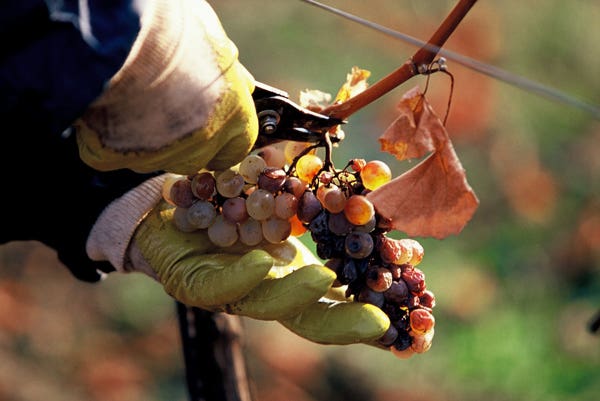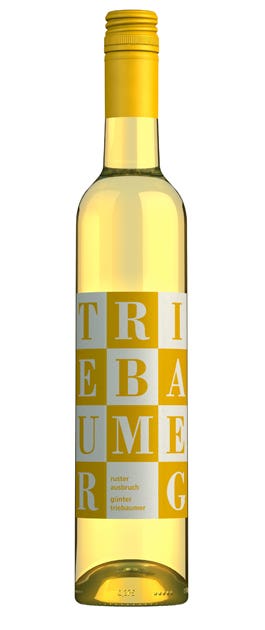
Austria’s (Surprising) Sweet Wines
Aside from the inky Manischewitz I swilled at the Passover table growing up, and the count-them-on-one-hand glasses of port I've ordered after dinner on fancy nights out, my experience with sweet wines has been nearly nonexistent. If anything I have been an active skeptic—believing that sweet wines are for people who can't handle the real stuff, and carrying around my glass of dry, leggy red wine like a badge of honor.
But as I learned on a recent visit to Austria, sweet wines—meaning wines with high levels of residual sugar, made from grapes left hanging on the vine until late in the season, and often served with dessert—are regarded with as much reverence as Sachertorte. And for good reason. The wines I sampled were complex and surprising, demanding complete attention even after a full meal. They swirled like amber-colored maple syrup in the glass, releasing a honeyed perfume that was the olfactory equivalent of clearing away the dinner dishes, scraping the crumbs from the tablecloth and plunking a majestic pie in the middle of the table. The wines' sweetness, while powerful, was calmed with generous notes of fruit, and tempered by a slightly bitter finish—a gift from the botrytis or "noble rot" fungus that, in the right temperature conditions, develops on grapes at the end of the season and helps concentrate their flavor.
Today, the center of Austria's sweet wine production is located in the province of Burgenland, the country's verdant, sun-drenched answer to the Napa Valley. Erik Quam, the President of Magellan Wine Imports in Colorado, told me that Burgenland's residents, and particularly in the town of Rust (pronounced "roost"), pioneered the method of making botrytis wine more than 500 years ago. It turns out, the region's hot summers and foggy, cool autumns are ideal for the development of the noble fungus. Today, the town is so highly regarded for their connection to sweet wine production that they have their own designated category, Ruster Ausbruch.
In recent years, Austria's dry wines have started to find their way to American tables, with bold varietals like gruner veltliner (white), zweigelt and blaufrankisch (reds) quickly joining chardonnay and merlot in our collective wine lexicon. Sweet wines likely have a ways to go before they can claim the same. That's partly because making them is labor intensive and weather dependent, which means high quality sweet wines only make up 2-3 percent of Austria's overall production. It's also because the American palate is still unfamiliar with and (like I was) a bit wary about sweet wines. And yet, as I discovered, the wines themselves have a way of winning over even the most skeptical heart. One sip (and then another, and another) was all I need to shed my previous "sweet wine is for sissies" assumptions and raise a toast to the sweet life.
3 Bottles to Try
Look for Austrian sweet wines in smaller, 375 mL bottles and keep an eye out for the following categories: Ausbruch (and Ruster Ausbruch), Beerenauslese, Trockenbeerenauslese, Strohwein/Schilfwein, which means the grapes were dried on straw or reed mats before vinification, and Eiswein, or "ice wine," which means the grapes were allowed to freeze before harvesting.

Winemaker Heidi Schrock holds two distinctions in Austria: she runs one of the country's few woman-owned wineries (and founded the 11 Women and Their Wines association), and she is one of the leading and most respected producers of noble rot sweet wines. Her Beerenauslese has a spring-like, almost vegetal nose and a concentrated honeysuckle and lemon meringue pie taste. The finish is long and lush, making this wine a great pairing for a cheese plate.
Established in Rust in the 1930s, Feiler-Artinger is now a third-generation and, as of 2011, a certified biodynamic winery. 15 percent of the winery's 64 acres are devoted to sweet wine, like this elegant Ruster Ausbruch. The wine's deep golden color and vanilla scent give way to a rich palate of orange zest and caramelized sugar. Serve it alongside baked fruit tarts with whipped cream.
The Treibaumer family first came to Rust in the late 17th century, and have been making wine there for nearly that long. Gunter Triebaumer and his partner Regina Limbeck are among the family's newest generation of vintners, cultivating 39 and a half acres of grapes in Rust. Their sunshine-colored Ruster Ausbruch is complex and vivacious, tasting of ripe stone fruit, marmalade and juicy pear. Pair it with custardy desserts like the rich, cream-filled puff pastry, cremeschnitte.
Keep Reading
Continue to Next Story










